I collect unsolved historical ciphers in a separate article, to which I receive or find solutions from time to time. In May 2022, I received solutions of no less than 10 ciphers from George Lasry, a computer scientist and expert in cryptanalysis, who has solved many historical ciphers (some of which I mentioned). (It seems his solver can readily solve any cipher mainly based on letter-by-letter substitution, even with many homophones. I guess the most time-consuming process in his codebreaking is preparing a transcription to be fed to the algorithm, for which he developed a tool to assist manual work.) While there remain some unknown or uncertain symbols, his decipherments seem to generally make sense.
The following presents his solutions (key & decipherment) in chronological order.
(Within a month after the first batch, I received additional solutions (also included in the following), which doubled the number to 21.)
In 2023, I received additional 15 solutions.
See another article for ciphers during Francis I's reign.
BnF Clair. 329(Gallica), f.9 is annotated as Bayonne's. As seen in the images below, it uses a cipher different from a known cipher used by Bayonne in f.139 (1529).
The same key also fits Clair. 328, f.291 (Bayonne to Montmorency, 28 October 1528). Since this letter is printed in Ambassades en Angleterre de Jean Du Bellay (from BnF fr.3077, p.145-147; the beginning of f.291v corresponds to the last paragraph on p.432 of vol.1 (Google)), comparison may reveal more symbols.
I could not find the letter of Clair. 329 in the printed edition. But since the editor was aware of Clairambault 330 (p.7, n.3; p.118, n.2), it may be simply that I overlooked it.
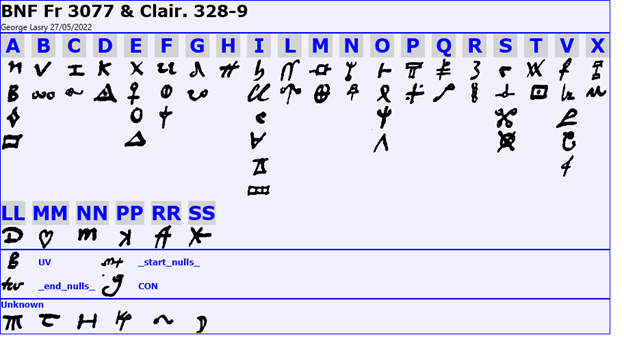



BnF Clair.330 (Gallica), f.53 is a letter from Mr. de Gramont, Bishop of Tarbe (Wikipedia), to Montmorency (Rome[?], 5 October 1529). It uses a cipher different from a known cipher used in 1530.
(In 1525, the Bishop of Tarbe had been despatched by Queen Regent, Louise of Savoy, (mother of Francis I) to obtain the freedom of the king in captivity in Spain. Then, he was sent to England to encourage Henry VIII to divorce Catherine of Aragon. Then, he was sent as ambassador to Rome.)
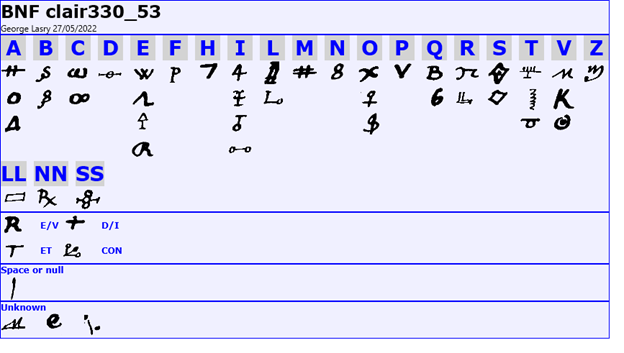

BnF fr.3081 (Gallica), f.41, is a letter wholly in cipher ("Dupplicata des articles envoyez par messrs les marechaulx françoys au roy"). It is solved as follows.
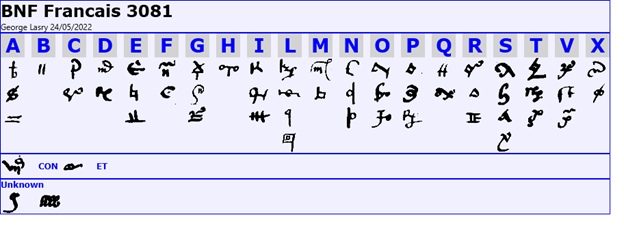



George found the same key is applicable to BnF Dupuy 265 (Gallica), f.132, which is a letter from Bishop of Mâcon to the king (29 May 1535) according to catalogue information. Its beginning can be read as follows.

Although the marshals' letter is filed with letters from the 1520s, it may also be from ca. 1535. Mâcon was ambassador in Rome from 1534 to May 1538. I wonder whether it has something to do with the Italian War of 1536-1538 (Wikipedia). Historian's help is needed to find out how the same cipher came to be used by the marshals and the bishop.
See another article for ciphers during the reign of Henry II of France.
BnF Dupuy 44 (Gallica) has a ciphertext (f.39), which, according to the catalogue information, corresponds to a decipherment (f.40), a letter of Philibert Babou de la Bourdaisiere (c. 1484-1557) (Wikipedia) from his son, Philibert (made cardinal in 1561) (Wikipedia).
With this pair of ciphertext and plaintext, I could not reconstruct the cipher. To me, the plaintext (containing about 3000 letters according to my very rough counting) seemed too long for the neatly written ciphertext (about 1000 letters). George Lasry's solution now made it clear that the ciphertext is independent from the plaintext letter. Now it is interesting to see to whom the ciphertext should be attributed.




BnF Dupuy 265 (Gallica) contains several cipher texts, which Paul Friedmann used to reconstruct some ciphers (see another article). George Lasry noted the cipher f.101 is left undeciphered and solved it as follows. According to catalogue information, it is a letter of Charles Marillac, ambassador in Germany, to cardinal Jean Du Bellay (Bishop of Bayonne), Augsburg, 18 November 1550.


BnF Dupuy 265 (Gallica) also contains an undeciphered letter from Montmorency to cardinal Du Bellay (f.228-238). It is solved as follows. (This may be the same as f.231 in Paul Friedmann's list.)


BnF Dupuy 265 (Gallica) also contains an undeciphered letter from Nicolas Raince, resident in Rome, to cardinal Du Bellay (f.336) (not in Paul Friedmann's list). It is solved as follows despite the shortness of the ciphertext. The cipher turned out to be monoalphabetic.



BnF fr.3138 (Gallica), f.59, is a letter from Claude de la Guiche, Bishop of Mirepois, to Montmorency (Rome, 22 November 1551) (which was not in my list). The cipher is solved as follows.




The volume contains more ciphertexts already deciphered.
See another article for ciphers during the reigns of Charles IX and Henry III.
A letter (BnF Colbert 395, p.335) from Jean Hurault[?], French ambassador in Venice, is solved as follows. (As it turned out, the plaintext is in p.337, which generally proves the accuracy of the solution and will allow identifying a few more symbols.)


A letter in cipher from Charles IX to Philibert du Croc is reproduced in Paul Destray (1924), Un diplomate français du XVIe siècle: Philibert du Croc (Gallica) (p.80 and the next leaf). Although the letter is not dated, the endorsement indicates Philibert du Croc was then ambassador in Scotland. See another article for contemporary ciphers.
This is solved as follows.



A letter "to the King" in BnF fr.3254 (Gallica), f.76, is almost entirely in cipher. (This was not in my list.) The volume contains many letters of Charles IX or Catherine de Medicis to Matignon and others from 1570-1573 and a copy of one letter of François de Cornelian, bishop of Roddez from 1583.
This is solved as follows.






There are letters to Mr de Mercoeur probably from the Duke of Guise in BnF fr.15564 (Gallica), f.27, f.78, f.119, f.142 The same cipher is used in letters "probablement de princes de la maison de Guise" in BnF fr.15565 (Gallica), f.105, f.122.
The solution is as follows. (The nomenclature symbols appear to be Roman numerals.)


The cipher used in letters in BnF fr.15565, f.7, f.62, and f.91 are deciphered as follows.


(Gallica), f.50, is solved as follows. (The solution is preliminary because the ciphertext is too short.)


A letter in cipher from Villeroi to Henry III of France was sold at an auction. It is wholly in cipher except for the complimentary ending: "Sire ie prie dieu conserver vre mté en parfaicte santé / De Bergerac ce viiie jour de sepbre 1577" and the signature "Vre très humble très obéissant & très obligé subjet & serviteur. Deneufville" in Villeroi's hand. (The date is shortly before the Treaty of Bergerac (Wikipedia) was made between the King and the Huguenot princes.)
This is solved as follows. (I had made a try by using some interlinear decipherment, but was unsuccessful (my blog).




An unsigned letter, wholly enciphered, dated January 1586 is in BnF fr.15572, f.43 (see another article). It is solved as follows.




The cipher used in a letter of Duval to Villeroi in f.127 of BnF fr.15573 (Gallica) is solved as follows. It appears to be a sequel of f.124 (the intervening f.126 is another letter), which is by René Duval, Sr de Stors according to catalogue and in which the key below reveals words such as "j'estim", "promect", "au[x] les forces leur ... agreable".



A letter partly in cipher to(?) "Monsieur Pasquier Lrre[?] des finances" (?Wikipedia) (1592) is in BnF fr.4712, f.35 (see another article). (According to catalogue information, this is no.26 "Fragment de notes et reflexions sur la conduite a tenir par Henri III pour abattre "les huguenots".) It is solved as follows.
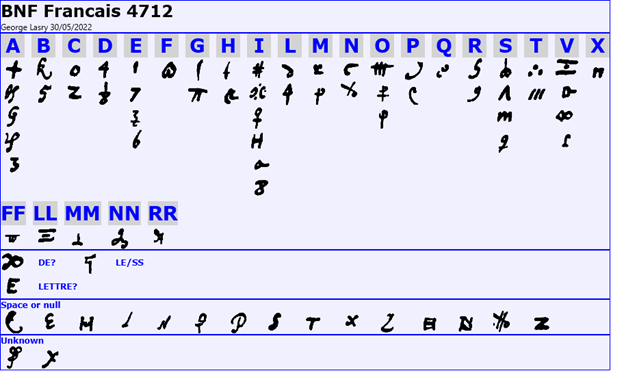

See another article for ciphers during LouisXIII's reign.
BnF Baluze 155 (Gallica), f.79, contains a letter, dated Dijon, 28 March 1631, of Louis XIII (undersigned Bouthillier) to Melchior de Sabran, a diplomat then resident in Genoa (1630-1637). It has a paragraph in cipher. It is solved as follows.



George Lasry confirmed this cipher is also used for many letters of Sabran in BnF fr.4134 and fr.4135.
BnF Baluze 156 (Gallica), f.40, is wholly enciphered, undeciphered. It seems to be an enclosure of a letter (in French) of Odoardo [Édouard] Farnese, Duke of Parma (Wikipedia), to Sabran, dated Plaisance, 27 May 1637. It is solved as follows.


See another article for contemporary Spanish ciphers.
A letter in cipher in BnF Espagnol 318 (Gallica) (f.122, no.95, 8 January 1497) is solved as follows (it is "approximate").


In 2023, George Lasry provided solutions of no less than 15 unsolved ciphers in BnF, most of which were not in my list. In the following, I collated the keys provided by him with catalogue information and ciphers known from elsewhere (if any).

(<44> may be DE from the last line of f.95: uno de los dos grandes ministros. But this should yet be checked in other instances.)
This cipher is uesd in the following letters in BnF Espagñol 336 (Gallica). The count of Fuentes was Governor of the Spanish Netherlands in 1595-1596 (Wikipedia). Diego Pimentel was his nephew (Historia Hispanica):
f.95 no.49 Lettre de Diego Pimentel au comte de Fuentes, gouverneur des Pays-Bas. Madrid, 17 juin et 4 juillet 1595. En partie chiffree.
f.97 no.50 Lettre de Diego Pimentel au comte de Fuentes, gouverneur des Pays-Bas. Madrid, 4 juillet 1595. En partie chiffree.
The ciphertexts in BnF es.336 are as follows:
f.69 no.36 Lettre de Juan de Cuniga a Frances de Alava. Rome, 5 novembre 1571. *Cg.4 (see another article)
f.81 no.42 Lettre d'"El duque de Sessa," D. Antonio Fernandez de Cordova, a Philippe II. Roma, 29... 1596. *Cp.57 (see another article)
f.95 no.49 Lettre de Diego Pimentel au comte de Fuentes, gouverneur des Pays-Bas. Madrid, 17 juin et 4 juillet 1595. En partie chiffree. (Fuentes-Pimentel Cipher above)
f.97 no.50 Lettre de Diego Pimentel au comte de Fuentes, gouverneur des Pays-Bas. Madrid, 4 juillet 1595. En partie chiffree. (Fuentes-Pimentel Cipher above)
f.101 no.52 Lettre d'"El conde de Benasco," Pedro de Mendoca, a Philippe II. Genes, 10 avril 1597. *This seems to be a substitution alphabet plus three-figure code for syllables and some words, alphabetically arranged. Diacritics (: ^) seem to be used consistently but may be meaningless.
f.148 no.74 Lettre d'Antonio Descovar a Diego de Ibarra, a Paris. Madrid, 15 novembre 1593. *Almost monoalphabetic.
f.158,f.159,f.160 no.79-81 Trois lettres de l'ambassadeur de Savoie a son souverain. 2 mars, 4 juillet et 18 mai 1593. Duplicata en partie chiffres. En francais. *The first cipher at another article. There may be many additional symbols.
George found f.164-186 all use the same cipher (no.54 of the Nevers Collection) and found some vowel indicators not in my reconstruction (another article).
f.164,f.166 no.83-84 Deux lettres de Diego de Ibarra au duc de Feria et au prince Doria. Paris, 4 novembre 1592 et 9 janvier 1594. En partie chiffrees.
f.169,f.171 no.85-86 Deux lettres de Joan Battista de Tassis a Josephe de Acuna, ambassadeur d'Espagne a Turin, et au comte de Vinasco, ambassadeur a Genes. Paris, 11 janvier 1594.
f.173 no.87 Lettre de Diego de Ibarra a Juan de Idiaquez. Paris, 15 novembre 1593. En partie chiffree.
f.175,f.177,f.179 no.88-90 Trois lettres d'"El duque de Feria," Lorenzo Suarez de Figueroa, a Juan de Idiaquez, a Martin de Ydiaquez et a Christoval de Mora. Paris, 4 janvier 1594. En partie chiffrees.
f.181,f.183 no.91-92 Deux lettres de Diego de Ibarra au prince Doria et a D. Juan Fernandez de Velasco, connetable de Castille, gouverneur de Milan. Paris, 15 novembre 1593. En partie chiffrees.
f.185 no.93 Lettre du duc de Feria a Philippe II. Paris, 30 decembre 1593. Chiffree.
f.196 no.99 Lettre de Matheo de Segura au connetable de Castille. Madrid, 8 aout 1596. Passages en chiffre. *Short ciphertext, undeciphered.
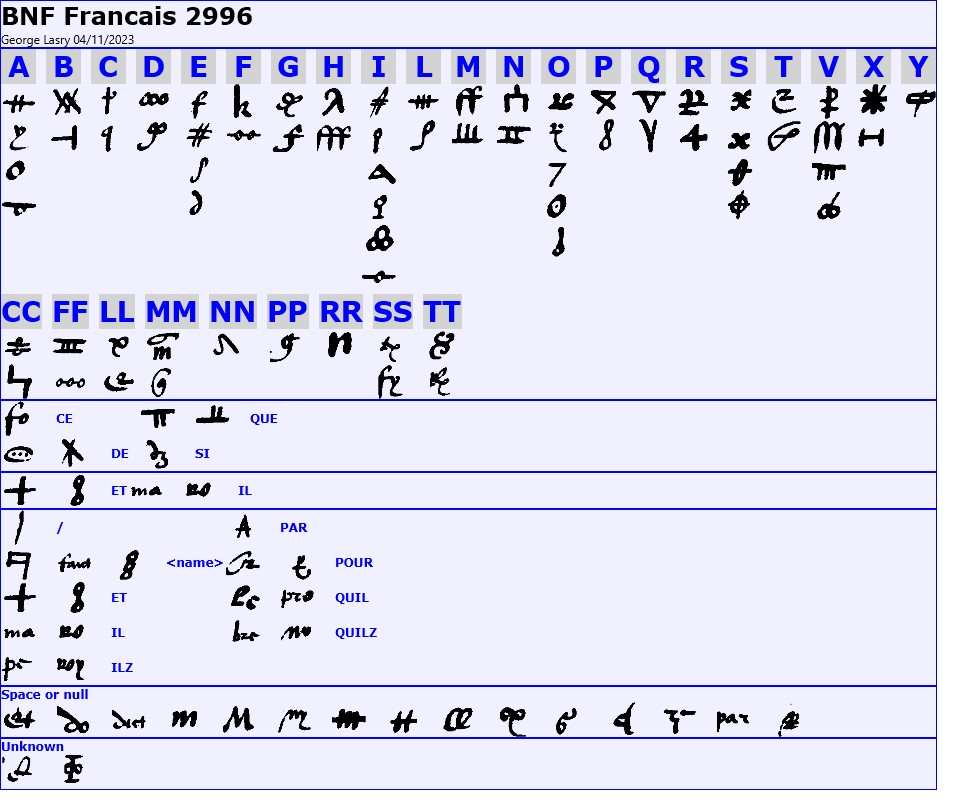
(The symbol "|| with a strikethrough", representing A, looks like a null symbol, which seems to be "tt." The symbol "||| with a strikethrough", representing L, looks like a null simpol, which seems to be "m with a strikethrough.")
This is used in the following letter in BnF fr.2996 (Gallica):
f.52 no.25 Depeche en chiffre de "DE MORVILLIER (Wikipedia),... au roy... De Venize, le XXIIIIe jour de janvier 1546"

This is used in the following letter in BnF fr.3015 (Gallica):
f.16 no.8 Lettre, en chiffre, de "CHARLES", duc DE GUELDRES (Wikipedia), avec une adresse en chiffre.
George observes that many symbols are unnecessarily doubled in this ciphertext. I note such doubled symbols are "e" (or cursive "l") representing R and "d" representing S, and they never occur alone. Thus, I think the symbol for L is actually "ee" rather than "e" and the symbol for S is actually "dd."
BnF fr.3015 also contains ciphertext (in a different cipher, with decipherment) in the following letter:
f.91 no.40 Lettre chiffree au roi. "De Amptonhill, ce XXIIIe de juillet".
Partial reconstruction from BnF fr.3022, f.12:

(Three-letter codes are yet to be identified.)
This is used in the following letters in BnF fr.3022 (Gallica) and also in BnF Clair.326 (presented in another article).
f.12 no.5 Lettre chiffree, en espagnol, de "PEREZ" a l'empereur Charles-Quint. "De Roma, XXIIII° de septiembre 1527".
f.20 a loose sheet.
F.16 (no.6 Rapport, en espagnol, avec chiffre, a l'empereur Charles-Quint.) seems to remain unsolved. What seems to be a copy of f.12 is in BnF Clair. f.49.

This is used in the following letters in BnF fr.3022 (Gallica):
f.26-28 no.10 Lettre, en espagnol, avec chiffre, d'"el marquese DEL GASTO" a l'empereur Charles-Quint. "De Ysola, XXVII de setiembre 1527"
f.39 a loose sheet.
F.40-43 (no.19 Lettre chiffree d'"el marquese DEL GASTO" a Charles-Quint. "De Roma, VI de noviembre M.D.XXVII") seems to remain unsolved.
(I call this "De la Tremoille's(?)" only for expediency. The letters in cipher in BnF fr.3029 are filed with de la Tremoille's letters, but there is no evidence to attribute this de la Tremoille.)

This is used in the following letters:
BnF fr.3029 (Gallica)
f.67 no.34 Lettre en chiffre.
f.100,f.105 no.49 Lettres en chiffre. (F.105 has "voy les chiffres cy devant" in the margin. The cleartext as well as the plaintext are in Latin.)
f.134 no.59 Lettre, en chiffre, adressee " au roy ".
f.162 no.66 Lettres en chiffre.
f.172,f.176 no.68 Lettres en chiffre.
f.182 no.70 Lettre en chiffre.
f.186 no.72 Lettres en chiffre.
BnF fr.3092 (Gallica)
f.101 no.43 Memoire chiffre.
f.103 no.44 Autre memoire chiffre
f.107 no.46 Memoire chiffre.
I changed the dating to (??1520-1521). Originally, I labelled this as (ca.1520-1521) simply from other letters in clear in BnF fr.3092. If these letters were indeed from 1520-1521, they would be the earliest extant specimen of French cipher letters. In order to help dating, I edited two raw decipherments provided by George into readable text and added one (fr.3029, f.186) I deciphered.
The reference to the war in Hungary may refer to the Turkish invasion in 1520-1566 (Wikipedia).
The "royne d'Angleterre" may refer to Henry VIII's queen, but may also refer to Elizabeth I. The latter fits "Cardinal ... en Flandres", which may refer to the Cardinal of Granvelle (created in 1561).
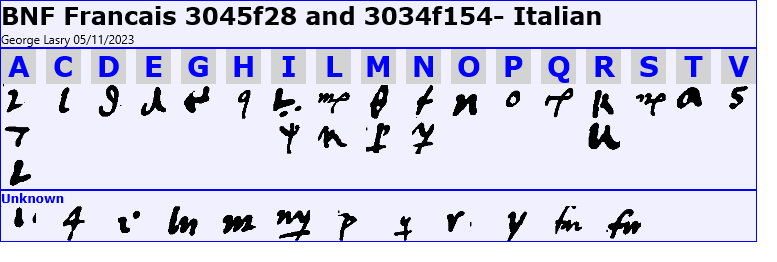
(One of the symbols for L looks very similar to one of the symbols for R to me.)
This is used in the following letters:
BnF fr.3045 (Gallica)
f.28 no.24 Lettre chiffree, en italien, de "GALEAZ VESCONTE" a "Angelo Bolano,... Da Alexandria, a li XII de ottobre 1528"
BnF fr.3034 (Gallica, also catalogued in Italian)
f.154 no.68 Lettre, en chiffre, "a mons. le grant maestre... Data al campo a Landriano (Wikipedia), a li XXX d'aust 1528"
BnF fr.3096 (Gallica)
f.91 no.47 Lettre chiffree, en italien, de "GALEAS VISCONTE,... al christianissimo re [Francois Ier]... Datum in campo, in la pieve de Loccate, a li XII de giugno M.D.XXIX "

This is used in the following letter in BnF fr.3034:
f.156 no.69 Lettre, en chiffre, d'"AMBROSIO BIZOZOLA,... allo... principe... Maximiliano Sforza (Wikipedia)"
The catalogue of this volume also mentions "cyfra" for f.160 (no.70 "Copia de avisi de una lettera parte extratta de cyfra de Alexandria"), but it is only the plaintext.

(Gallica)
Ciphers used in the five ciphertexts are identified as follows (for specific ciphers mentioned below, see another article):
f.12 no.4 Lettre, en chiffre, de "G[ABRIEL], cardinal DE GRAMONT,... a monseigneur... le grant maistre... A Rome, le XXVIIme jour de aoust ". *Gramont's Cipher (1530), which may now need to be renamed Gramont's Cipher (1527)
f.16 no.5 Lettre, avec chiffre, de " G[ABRIEL] DE GRAMONT, evesque de Tarbe... a monseigneur... le grant maistre... A Romme, le Vme jour d'octobre mil V.C.XXIX ". *Undeciphered. Deciphered by George immediately above. Previously deciphered by George farther above from Clair. 330. I call this Gramont's Cipher (1529)
f.18 no.6 Lettre, en chiffre, de " G[ABRIEL] DE GRAMONT, evesque de Tarbe... a monseigneur le grant maistre... A Boulongne, le XXVIIIme jour de mars ".*Gramont's Cipher (1530)
f.21(-p.43) no.7 Lettre chiffree de NICOLAS RAINCE " a monseigneur le grant maistre... Ce mercredi septme jour de novembre mil V.C.XXVI. Rome ". *Raince's Cipher
f.68(p.112-p.116) no.23 Lettre chiffree de " J[EAN] DU BELLAY, evesque de Bayonne... De Londres, le dernier de juing ". *Undeciphered. Bayonne's Cipher (1529)
(Gallica)
There are three ciphertexts.
f.19 no.11 Lettre, avec chiffre, de " NICOLAS RAINCE,... a monseigneur... le grant maistre... De Rome, ce jeudi XIIe jour d'aoust M.V.C.XXIX ". *reconstructed (to be published later)
f.25 no.14 Lettre de " G[EORGES] DE SELVE, e[veque] de Lavaur ", au roi. " De Venise, ce IIIIe de septembre 1535 ". *Selve's Cipher
f.45 no.23 Lettre, en chiffre, de " G[ABRIEL] DE GRAMONT, e[veque] de Tarbe... a monseigneur... le grant maistre et mareschal de France... A Romme, le XIme jour d'octobre ". *Deciphered by George above. Gramont's Cipher (1529)

This is used in the following letter in BnF fr.3071 (Gallica).
f.9 no.4 Depeche, avec chiffre, de CHARLES HEMART-DENONVILLE, " cardinal de Mascon... a monseigneur de Montmorency,... A Rome, le XIe jour d'avril 1537". *The same as Mascon's cipher from BnF fr.3053.
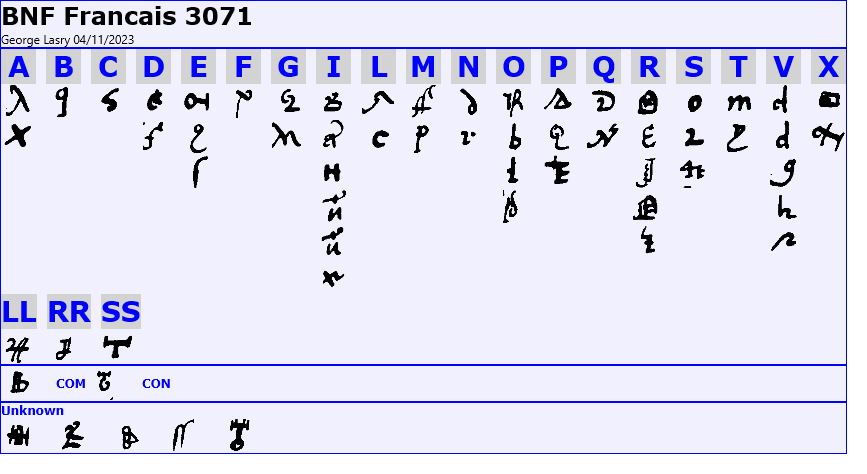
This is used in the following letter in BnF fr.3071 (Gallica).
f.17 no.7 Lettre, avec chiffre, de " GABRIEL, cardinal DE GRAMONT,... a monseigneur le grant maistre... A Rome, le XXIe jour de juillet ". *Gramont's Cipher (1530)

(From the beginning ("mesmement") of another letter with decipherment on f.55v, "C" (and probably also "A") in the "unknown" can be safely deemed null.)
This is used in the following letters in BnF fr.3083 (Gallica).
f.20 no.8 Lettre, avec chiffre, de JEAN DE LANGEAC, "evesque d'Avranches... a monseigneur... le grant maistre... Escript a Venise, ce XIIIIme de janvier"*Avranche's Cipher 1.
f.55 no.22 Lettre chiffree de JEAN DE LANGEAC, "evesque d'Avranches... a monseigneur... le grant maistre... Escript a Venyse, le XVme de septembre " *With interlinear decipherment.

This is used in the following letters in BnF fr.3096 (Gallica). Gaspar Sormano is also spelled as Gaspard Sormano.
f.113 no.62 Lettre en italien, avec chiffre et dechiffrement, de " GASPAR SORMANO,... al re [Francois Ier]... Da Ferrara, 22 marzo 1529 ".
f.105 no.63 Lettre, en italien, avec chiffre, de GASPAR " SORMANO " et de " JOACHIN... DE VAULX " au roi Francois Ier. " Da Ferrara, penultimo de febraro M.D.XXVIIII ".
f.117 no.64 Lettre, en italien, de JEAN DE LANGEAC, " e[veque] d'Avranches ", et de " JOACHIN... DE VAULX ", au roi Francois Ier. " Da Vinecia, el VI di magio 1529 ".
f.119 no.65 Lettre, en italien, avec chiffre, de " GASPAR SORMANO " et de JOACHIN " DE VAULX " au roi Francois Ier. " Da Ferrara, alli XXIII febraro M.D.XXVIIII ".
f.121,f.123 no.66 Lettre, en italien, avec chiffre, de " GASPAR SORMANO " et de " JOACHIN " DE VAULX au roi Francois Ier. " Da Ferrara, alli 23 febraro 1529... Duplicata ".
f.124 no.67 Lettre avec chiffre et dechiffrement : " Doppio de lettere scritte per mi GASPAR SORMANO al Sr duca d'Urbino ".

This is used in the following anonymous note in BnF fr.3147 (Gallica).
f.35 no.15 Memoire en chiffre.
George deciphered f.62 of BnF fr.3976, after which he realized it was already mentioned in my article.